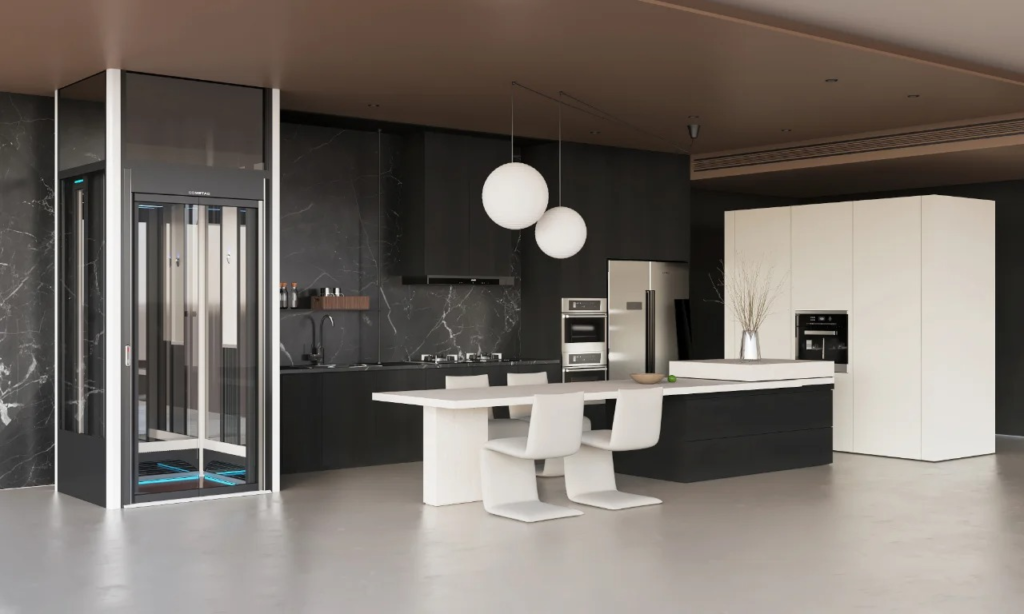The modern home elevator, as an innovative vertical mobility solution, is redefining global living experiences in high-end residences and aging societies. From smart controls to sustainable design, its technological advancements and market demands are driving the industry toward efficiency, personalization, and decarbonization.
Technological Innovation: Drive Systems and Intelligent Integration
The core innovation of modern home elevators lies in diversified drive systems and integrated smart controls. Traditional traction elevators are being replaced by screw-driven and machine room-less (MRL) models due to space efficiency. For instance, China’s Longchuang Elevator combines traction and screw-driven mechanisms to enhance safety and space utilization, ideal for villas and compact apartments1. Sweden’s Cibes Symmetry offers the “Ascenda” MRL elevator, which can be installed within 48 hours, making it a top choice for heritage building renovations.
IoT and AI further elevate user experience. Otis’s Compass 360 system supports voice commands and biometrics, allowing real-time monitoring via smartphone apps with 92% predictive maintenance accuracy. Federal Elevator’s all-glass cabins with electrochromic glass technology switch between transparent and opaque modes, balancing privacy and aesthetics.

Design Trends: From Utility to Aesthetic Core
The design philosophy of modern home elevators has shifted from mere functionality to becoming a centerpiece of home aesthetics. Customized designs and glass cabins account for 45% and 30% of the global market, respectively. European brand Aritco’s modular elevators offer personalized finishes, seamlessly blending with interior styles or even serving as art installations.
Aging populations drive design innovations. Japan’s compact elevators (250kg capacity) feature barrier-free entries, enabling seniors to “age in place” in multi-story homes3. Hangzhou Shunda Bonait’s MRL elevator patent simplifies installation, minimizing structural impact and becoming a preferred solution for old neighborhood renovations.

Market Drivers: Aging Demographics and Smart Homes
Global aging trends are a key driver for modern home elevators. The U.S. population aged 65+ is projected to reach 94.7 million by 2060, fueling an 8.5% annual demand growth. China’s 14th Five-Year Plan prioritizes aging-friendly renovations, with a 2024 investment of ¥6.2 billion to upgrade 41,000 elevators.
Smart home integration expands market boundaries. The smart elevator market is expected to grow from 11 billionin 2024 to 25 billion by 2030. Thyssenkrupp’s MAX system uses AI to optimize dispatch, increasing peak-hour capacity by 35%. Singapore’s Marina Bay Sands integrates elevators with security systems for contactless access, serving 20,000 daily users.

Challenges and Future Trends: Standardization, Cost, and Sustainability
Key challenges remain:
Cost Barriers: Smart elevators cost 30% more than traditional models, limiting adoption in developing markets;
Regional Standards: ‘EN81-20 and China’s GB standards complicate global supply chains;
Cybersecurity Risks: Data breaches in connected elevators accelerate quantum encryption adoption.
Future trends focus on convergence and sustainability:
Hybrid Systems: Maglev-solar hybrids enable zero-carbon operation. KONE’s SolarLift feeds 20% of energy back to grids;
Digital Twins: Microsoft and Schindler’s virtual models simulate extreme conditions, cutting maintenance costs by 18%;
Circular Economy: EU regulations mandate 90% component recyclability, promoting modular designs and 3D-printed localization.
The modern home elevator’s global evolution reflects both technological prowess and humanity’s response to urbanization and aging. From Scandinavian minimalism to Chinese smart manufacturing, its trajectory underscores vertical mobility’s role as a linchpin for a sustainable future. The synergy between green technologies and digital ecosystems will propel the industry toward higher-dimensional innovation.





